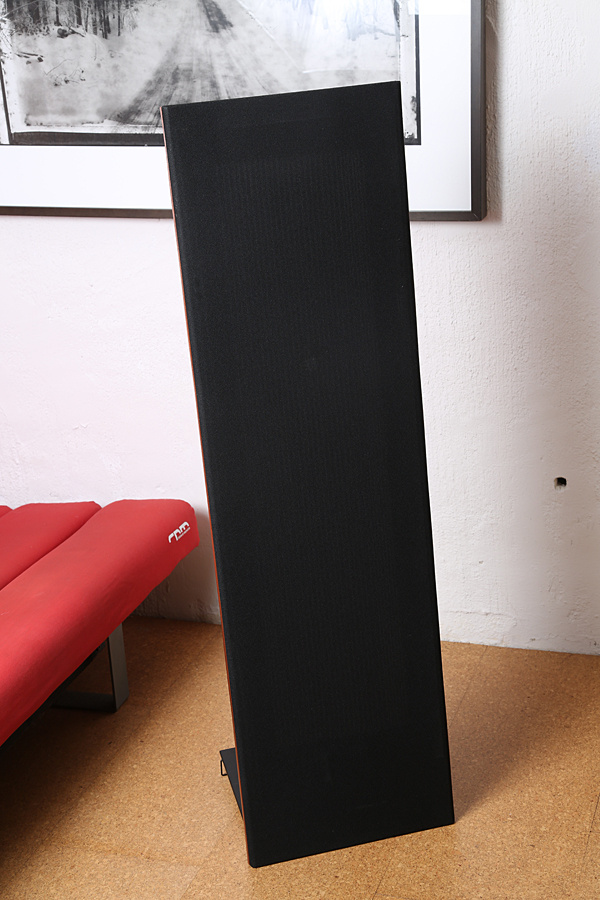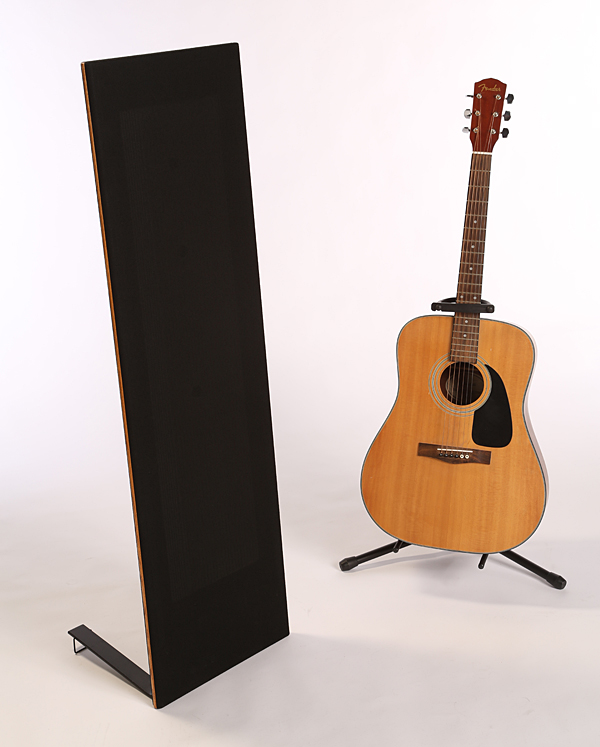Magnepan LRS Loudspeaker Review Page 2
Setup
As with any open-baffle dipole speaker, the positive-polarity sound the LRS puts out into the room is matched by an equal amount of reverse-polarity sound firing to the rear, so positioning is critical. These speakers really need room to breath, and I found they worked best when placed a full three to six feet out from my room's front wall. Adjusting their angle relative to the listening position is also important; this acts like a high-frequency tone control while also letting you dial in sonic focus similar to the lens on a camera. Magnepan says you can experiment with arranging the tweeters on either the inside or outside, with results depending on the size of the room. I found I could achieve greater depth and dimensionality in my 14- by 16-foot space with the tweeters on the inside. Magnepan also suggests adjusting toe-in so that the tweeters sit about an inch further away from a listener's ears than the woofers. This turned out to be good advice and delivered a better blend between the woofer and tweeter, plus a smoother overall balance. The speaker's vertical dispersion is optimized for a seated listener, with a little metal hoop on the back of each L-shaped foot allowing you to make a fairly crude adjustment of the backward tilt. Given my low-ish seating position, this turned out to be a handy adjustment, although I would have appreciated the ability to get the LRS pair sitting even a little more upright.
With so much space out from the walls needed to optimize performance, a common complaint will likely to be that the LRS is simply too physically dominant in the room. But there's actually a simple fix for that problem. At around 20 pounds each including the legs and no spikes or other floor-coupling devices, these speakers are really easy to move around, so when you want to sit and enjoy music you can quickly move them to the ideal positions, and then tuck them up near the wall again when you're done. They're no harder to move than a couple of ironing boards, and most of us don't have a problem with dragging one of those out when we need it.

Just as Magnepan suggested, the LRS proved to be especially fussy about what type of amplifier I used to drive them. I started off with a Marantz SR-6014 receiver, which at 110 watts-per-channel should have provided plenty of power. But while the sound with the Marantz was clear and focused, I wasn't able to achieve the sense of liveliness and punch I have heard from the LRS in other setups. Next, I tried a 150 watts-per-channel Denon AVR-X8500H receiver. This brought back much of the missing excitement, but the power step-up from the Marantz also left me wondering how much further I could push things on the amplifier side and still hear improvements.
Using a $10,000 Pass Labs INT-150 amplifier to drive a $650 pair of speakers is kind of an absurd combination, but the improvement I heard over the receivers, despite the Pass Labs amp having the same on-paper power spec as the Denon, shows that Magnepan wasn't kidding when it said the LRS wasn't designed with compromises for budget systems in mind. Friends of mine have reported excellent results using affordable amps like the Schiit Audio Vidar and Rogue Audio Sphinx with the LRS, proving that you don't need a system with a five-figure price tag to get excellent results. Interestingly, it seems that the critical factor is not how many watts an amp can deliver to the LRS, but how well it delivers current into a low-impedance load (the LRS has a specified impedance of 4 ohms).
With any speaker having limited bass extension and bass power, there's always temptation to saddle it with a subwoofer. I did try the LRS with an SVS SB-2000 Pro sub, which did a good job blending with the lightning-fast panel, but this review is ultimately about the LRS without add-ons.
Performance
Scrolling through Qobuz to find some tasty tunes to stream, I settled on the famous 1961 live Bill Evans Trio recording from the Village Vanguard jazz club in New York City. Right out of the gate I heard many similar qualities between the Magnepans and the Quad ESL-57 speakers I use every day, with LRS delivering high levels of transparency and coherency. The volume of air in this tiny club, one I'm familiar with, was instantly recognizable, with every murmur from the audience or clink of glasses on the bar plainly audible. The sound of Evans' piano had the percussive attack of the real thing, while Paul Motian's cymbals sizzled. But the real star of this recording is young bassist Scott LaFaro, whose blazing virtuosity was cut short by a car accident just days later. LaFaro's fingering and speed were startlingly clear through the LRS, and while the panel didn't deliver the deep thunder of his instrument, I didn't really feel like I was being short-changed.

For a complete change of pace, I next played a 1973 recording of Vivaldi's flute concerto La Notte , performed by Nikolaus Harnoncourt with his chamber orchestra. This extraordinary recording has the orchestra sitting in the middle of a very live-sounding church, but through the LRS the direct sound of the instruments blended perfectly with the acoustics of the space in a way that made me feel I was right there. The tonality of the original instruments came across in bold, bright colors, from the bite of the bassoon to the woodiness of the period-style flute.
To ramp things up a bit, I streamed the title track from Janis Ian's Breaking Silence album via Tidal and immediately heard that famous bass impact I'm familiar with from other Magnepan speakers. While it may not have the ability to deliver deep, sustained low bass, the LRS certainly did a fine job delivering the leading edge and impact of the bass notes. I first noticed what I call "Maggie Bass" almost 40 years ago when I was listening to a friend's MG-IIIs and noticed how his otherwise relaxed cat would flip its head around to look at the speaker each time the drummer thumped his kick drum. I'm happy to say that effect carries over to the little LRS. Besides the bass quality, the clarity of the acoustic guitar and Janis' almost whispered vocals were pretty extraordinary for a speaker at this price.
Conclusion
They say that with high demands come great rewards, and that certainly holds true with the Magnepan LRS. While it's not exactly an "all-rounder" speaker, the LRS does make for a compelling gateway drug to the world of high-performance audio. The better you feed it, the better it gives back, so perhaps Wendell was right in characterizing the LRS as an appetizer for the Magneplanar line. But then again, I've been to restaurants where the appetizers were so good that I wanted more of those rather than moving on to a main course. After the meal, you can always drive home in your $30,000 Ferrari.





























































